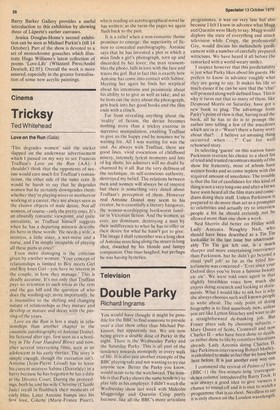Cinema
Tricksy
Ted Whitehead
Love on the Run (Gala) 'This degrades women' said the sticker slapped on the underwear advertisement which I passed on my way to see Francois Truffaut's Love on the Run (AA); I shouldn't think that the opponents of sex-. ism would care much for Truffaut's romanticism, the other side of the same coin. It would be harsh to say that he degrades women but he certainly downgrades them: whether they're playing wives or mothers or working at a career, they are always seen as the elusive objects of male desire. Not all women, of course — only the pretty ones. It's an absurdly romantic viewpoint, and quite. unrealistic, as Truffaut himself suggests when he has a departing mistress describe his hero in these words: 'He needs 4 wife, a mistress, a little sister, a wet-nurse and a nurse, and I'm simply incapable of playing all these parts at once!'
Even more damaging is the criticism given by another woman: 'Your concept of relationships is limited to Boy meets Girl and Boy loses Girl you have no interest in the couple, in how they manage.' This is deadly accurate. It's not only that Truffaut pays no attention to such trivia as the rent , and the gas bill and the question of who does the washing-up; more importantly, he is insensitive to t he shifting and changing nature of relationships as they mature and develop or mature and decay with the passing of the years.
Love on the Run is less a study in rela tionships than another chapter in the onanistic autobiography of Antoine Doinel, his fictional alter ego, first seen as a school boy in The Four Hundred Blows and now,, after several intervening films, seen as an adolescent in his early thirties. The story is simple eneeigh, though the execution isn't. Antoine (jean-Pierre I...eaud) has to leave his current mistress Sabine (Dorothee) in a hurry because he has forgotten he has a date at the Divorce Court, During the proceedings, both he and his wife Christine (Claude Jade) recall in flashback their moments of early bliss. Later Antoine bumps into his first love, Colette (Marie-France Pisier), who is reading an autobiographical novel he has written; as she turns the pages we again flash back to the past.
It is a relief when a non-romantic theme promises to emerge: the superiority of fiction to concealed autobiography. Antoine says that he has invented a plot in which a man finds a girl's photograph, torn up and discarded by her lover; the man reassembles the photo, falls in love with the face and traces the girl. But in fact this is exactly how Antoine has come into contact with Sabine. Meeting her again he finds her sceptical about his intentions and pessimistic about his ability to to give as well as take; and so he trots out the story about the photograph, gets back into her good books and the film ends with a clinch.
Far from revealing anything about the 'reality' of fiction, the device becomes nothing more than a tricksy exercise in narrative manipulation, enabling Truffaut to give us t he happy end he assumes we're waiting for. All I was waiting for was the end. As always with Truffaut, there are good lines, vivid evocations of childhood misery, intensely lyrical moments and lots of leg shots: his admirers will no doubt be charmed by it all. But the very deftness of the technique, its self-conscious authority, destroyed my belief. The relations between men and women will always be of interest but there is something very dated about Truffaut's perception of them. However real Antoine Doinel may seem to his creator, he is essentially a literary hangover, the woman-worshipping bookworm familiar in Victorian fiction. And the women, as ever, are dominant, destroying a man by their indifference to what he has to offer or their. desire for what he hasn't got to give. The image I shall remember was a long shot of Antoine marching along the street in long shot, dwarfed by his blonde and lumpy companion. One man laughed, but perhaps he was having hysterics.


































 Previous page
Previous page